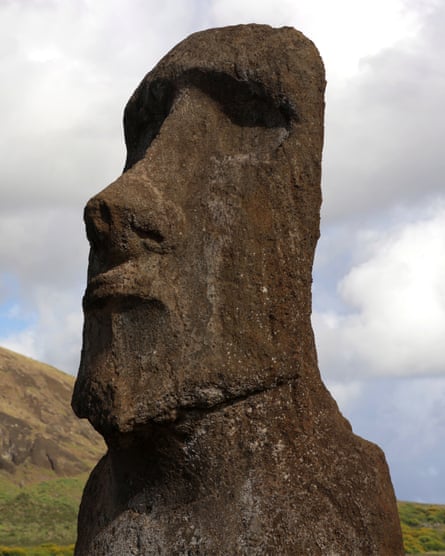The huge stone figures of Easter Island have beguiled explorers, researchers and the wider world for centuries, but now experts say they have cracked one of the biggest mysteries: why the statues are where they are.
Researchers say they have analysed the locations of the megalithic platforms, or ahu, on which many of the statues known as moai sit, as well as scrutinising sites of the island’s resources, and have discovered the structures are typically found close to sources of fresh water.
They say the finding backs up the idea that aspects of the construction of the platforms and statues, such as their size, could be tied to the abundance and quality of such supplies.
“What is important about it is that it demonstrates the statue locations themselves are not a weird ritual place – [the ahu and moai] represent ritual in a sense of there is symbolic meaning to them, but they are integrated into the lives of the community,” said Prof Carl Lipo from Binghamton University in New York, who was co-author of the research.

Easter Island, or Rapa Nui, has more than 300 megalithic platforms, each of which might have been made by a separate community. The first of these are believed to have been constructed in the 13th century, and many are found around the coast.
It is thought the monuments represent ancestors and were linked to ritual activity, forming a focal point for communities, but the reason for their locations was previously a mystery. While studies have suggested the sites might have been chosen because of a link to key resources, the team says the latest research is the first attempt to scrutinise such claims.
The team focused on the east of the island, where various resources have been well mapped, and looked at the distribution of 93 megalithic platforms constructed before European sailors turned up in the 18th century.
After finding no link to the proximity of rock used for tools or for the monuments, they looked at whether the ahu were found near other important resources: gardens spread with stones in which crops like sweet potatoes were grown, sites linked to fishing, and sources of fresh water.

Lipo said he became interested in the latter after he and his colleagues began delving into where those living on Rapa Nui got their drinking water from. The island has no permanent streams, and there is little evidence that residents relied on the island’s lakes.
However, fresh water passes through the ground into aquifers, seeping into caves as well as emerging around the coast. “It is sort of amazing at low tide when the water goes down, suddenly there are streams running off at different spots right at the coast that are just pure fresh water,” said Lipo. “We noticed this, actually, when we were doing a survey on the island, that we would see horses drinking from the ocean.” Historical records reveal islanders drank this rather brackish water, while studies suggest they also made wells to capture drinking water.
The results of the new research, published in the journal Plos One, reveal proximity to freshwater sites is the best explanation for the ahu locations – and explains why they crop up inland as well as on the coast.
“The exceptions to the rule about being at the coast where water comes out actually are met by the fact there is also water there – it is found through cave locations,” said Lipo, adding historic wells were found to explain some ahu locations apparently without fresh water.
Lipo said the results chimed with the team’s experiences on the ground. “Every time we saw massive amounts of fresh water, we saw giant statues,” he said. “It was ridiculously predictable,” he added.
The results, said Lipo, made sense, as drinking water is essential for communities and it is impractical to have to walk miles for a quick swig. “You would do stuff near the fresh water,” he said.

But he says the study also adds weight to the idea that communities competed and interacted through monument building, in contrast to the idea that islanders engaged in lethal violence over scarce natural resources – something Lipo says there is little evidence for. Indeed, the team is now exploring whether various aspects of the statues such as their size or other features might be linked to the quality of the water resources, potentially offering a way in which a community could show off a competitive advantage to other groups of islanders.
And community and cooperation, stresses Lipo, were crucial in construction of the monuments. “Anything that brings you together is going to make you stronger and allow you to survive,” he said. “I think that is the secret to Easter Island.”
But not everyone agrees about the location of the statues. Jo Anne Val Tilburg, an Easter Island expert from the University of California, Los Angeles, said: “The existence of fresh water seeps near coastal ahu is well-known and was certainly important at European contact. However, such seeps are today, and probably always were, minor resources. It is highly unlikely, in my view, that these resources were of major importance in locating ahu during prehistory.”





